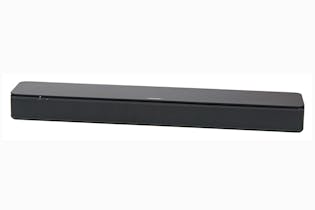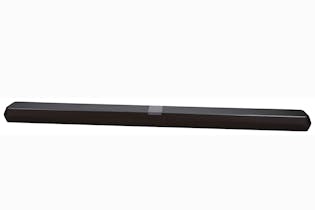Sound bars
Find the best sound bar for your home with our buying guide and test results for 16 new and 20 discontinued models.
A sound bar can bolster your TV with the audio quality it deserves. Before you buy one, find out what they’re capable of, how they work, and which features to look out for.

Why buy a sound bar?
TV displays are always improving, but sound quality often suffers as their frames become too thin to house decent speakers.
A sound bar is a plug-and-play device that fits snugly beneath your TV or mounts to a wall. It uses several internal speakers, sometimes paired with a wireless subwoofer, to create virtual surround sound.
A sound bar can emulate a home theatre system without the stack of speakers or annoying cables. They’re also cheaper, and easier to set up – usually, you only need one cable to connect the unit to your TV or other source.
A sound bar can do more than just play TV audio. Nearly all of them have Bluetooth and can act as wireless speakers when connected to a phone or tablet. Many can also connect to WiFi, which is even more versatile – for example, it lets you use a music streaming service such as Spotify, or a voice assistant like Siri, without routing through a phone or smart TV.
How they work

Sound bars deliver surround sound by projecting audio in several directions. Some of the sound bounces off the room’s walls so it appears to be coming from the left or right. High-end sound bars can also bounce sound off the ceiling.
The limitations
For all the claims about delivering multi-channel surround sound, sound bars aren’t all that good at it. You simply can’t get perfect 5.1 surround sound from a single source.
A wide or irregularly shaped room can disrupt the virtual surround sound. Furnishings can also soften or misdirect the reverberations.
Some sound bars come with separate rear speakers, which is the best way to get a genuine surround experience. However, they usually connect to the main unit via Bluetooth, so they’re susceptible to dropouts. Wireless subwoofers can suffer the same connection issues – you’ll really notice when the bass drops out while watching a movie.
TV compatibility
While any sound bar will work with your television, one from the same manufacturer tends to be simpler to connect. If you’re buying a new TV, retailers often offer a sound bar in a bundle deal.
Most sound bars can be controlled via your TV. So, for example, if you use the volume up button on the TV remote, it’ll crank up the sound bar. However, this may require delving into the TV’s settings – you’re usually looking for a setting called HDMI CEC (Consumer Electronics Control), but it varies by brand and model.
Features and jargon
Sound bars grew from the technical world of high-end audio systems. If you’re not an audiophile, here are some terms you need to know before you buy:
External subwoofer
A separate, larger speaker that produces deep bass. A subwoofer significantly improves audio quality at the low end, but be aware it may not fit beneath your TV.
Multi-channel codes (such as 5.1)
This code tells you how many independent speakers (or channels) there are.
The first number is how many are at ear level. Generally, “2” indicates regular stereo sound, “3” adds a separate channel for dialogue, and “5” or more means sound is projected beside or behind you for a surround sound effect.
The second number is how many subwoofers there are. It’ll either be 0 or 1.
If there’s a third number (for example, 5.1.4), it counts the speakers pointed toward the ceiling.
Dolby Atmos/DTS:X
The next evolution of the Dolby Digital and DTS technologies, these surround-sound codecs were created for cinemas in the early 2010s and are now appearing in home electronics. Both are ‘object-based’, meaning sounds are coded as three-dimensional objects that move through the space, providing deeper immersion.
HDMI eARC
ARC (audio return channel) is a feature that lets you transfer audio data from TV to sound bar through an HDMI cable. Every modern sound bar or TV has at least one HDMI port that supports ARC.
The newer eARC (enhanced ARC) connection is a high-bandwidth version of the same thing, which allows the transfer of richer, uncompressed audio. Technologies like Dolby Atmos and DTS:X can only be processed using eARC.
Airplay 2/Google Chromecast/Spotify Connect
These technologies use WiFi to stream audio from your phone or other device.
Macs, iPhones and iPads have Airplay built in so if you’re in the Apple ecosystem, a sound bar with Airplay 2 will suit you well. Similarly, one with built-in Chromecast is good for Android users.
Spotify Connect is a simpler way to play music through your speaker without needing a Bluetooth connection.

People's Choice
Our People's Choice awards are granted to brands that consistently rate above average for customer satisfaction and meet out other performance criteria. Become a member and see which brands have earned a People’s Choice award.
Which sound bars are most reliable?
We ask thousands of Consumer members about their products to find out which brands are most reliable and satisfying to own. The results are available to members and Digital Pass holders.
We've tested 36 sound bars.
Find the right one for you.
Bose

Bowers & Wilkins

